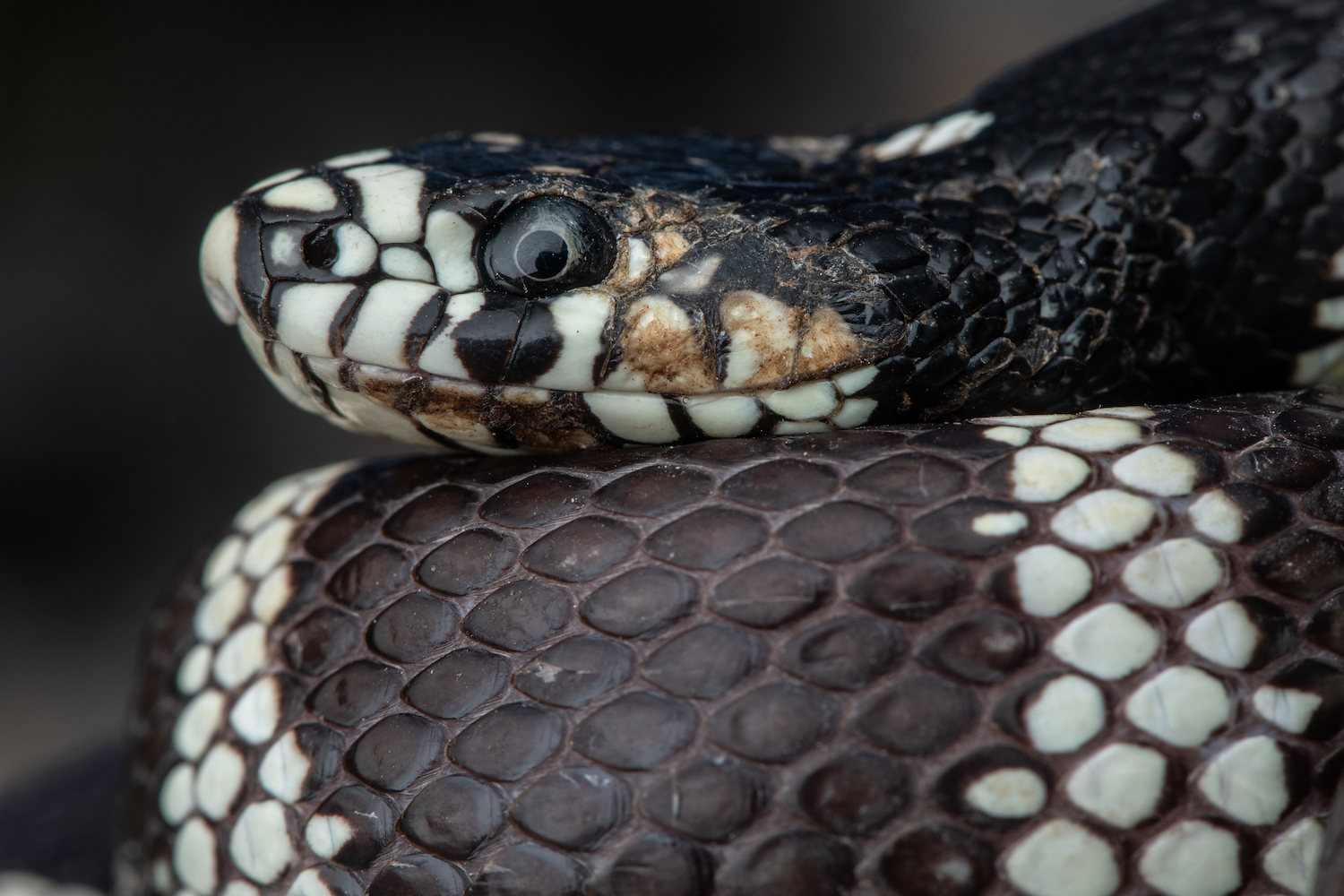
In 2019, alongside a roadway in Amador County, an odd California kingsnake caught the attention of a passerby. There was something wrong with it.
The snake’s head was a mess of scabs and lesions. Its mouth was distended and swollen. It was likely blinded by the nodules and crust on its face. The passerby collected the sick snake and took it to a rehabilitation center, from which it was eventually sent to a wildlife epidemiology lab. There, it tested positive for snake fungal disease (SFD). It was the first record of the disease in California. Not long after, SFD was detected in a second California snake, an invasive water snake near Sacramento.
Biologists took notice. History has shown that fungal pathogens must be taken seriously. The chytrid fungus in amphibians is responsible for more species extinctions than any disease in history. White-nose fungus in bats has killed millions of bats, and can rapidly wipe out colonies.
SFD has been known for several decades. Lately, though, it seems to be spreading fast, and has earned the classification of “emerging infectious disease.” Jeff Lorch, a microbiologist at the U.S. Geological Survey’s National Wildlife Health Center, recalls seeing the early cases from the eastern U.S., in the 2000s. Fungal pathogens are usually thought of as “more of an irritant than something that kills an animal,” he says. “So seeing those grotesque heads on these snakes that are swollen almost beyond recognition of it being a snake was very concerning, and somewhat perplexing.”
SFD was first identified at a den of timber rattlesnakes in New Hampshire in 2006, where it caused a die-off. Bewildered biologists began looking into it and identified a fungus species that was new to science. They called it Ophidiomyces ophidiicola, after the snakes it had infected (snakes are in the clade Ophidia).
In the years after its discovery, the disease rapidly undulated across Eastern North America before creeping westwards. California is just the latest of dozens of states in which infected snakes have been found. But the spread of Ophidiomyces may not be as simple as a westward-spreading front, Lorch says. Detections in museum specimens show the fungus present on snakes as early as the 1940s, even though nobody noticed any sick snakes until 2006. Maybe the fungus acquired a genetic mutation that allowed it to switch from asexual reproduction to a sexual form, which could help it evolve more virulent strains faster. Molecular evidence seems to suggest that some strains have been around for a long time and may already be widespread. Population genetics studies suggest that SFD originated outside of North America, perhaps hitching a ride here via captive snakes and the pet trade.
As SFD was detected ever more widely, some snake species died in droves, whereas others seemed to fare well, at least as far as biologists could tell. The effects of SFD can be more subtle than zombifying snakes, which can make detections difficult. It may change snake behavior, causing them to spend more time in the open and therefore more vulnerable to predators. Or it could make snakes less successful reproductively, or the infection could lie dormant only to surface when a snake’s immune system is under duress. All of these possibilities could result in an easily overlooked gradual population declines, rather than a dramatic die-offs.
Sign up today!

How the disease spreads remains somewhat mysterious. The fungus can survive in soil, and likely passes from snake to snake via mating, feeding, and even from mother to offspring. Or in crowded conditions where lots of snakes gather together, like overwintering sites. It may even be able to survive on hikers’ boots or on equipment that comes in contact with snakes. Luckily, for us at least, SFD cannot infect humans or anything aside from reptiles. In lab settings, researchers from the University of Wisconsin-Madison were able to show that lizards (snakes’ closest relatives) could become infected with SFD. But infected lizards haven’t been found in the wild.
After infected snakes were found in California, the state Department of Fish and Wildlife’s Wildlife Health Lab established a monitoring program, which was funded by the U.S. Fish and Wildlife Service, collaborating with the Wildlife Epidemiology Lab at the University of Illinois’ College of Veterinary Medicine.
Last summer, CDFW wrapped up the first year of monitoring, and it turned out the fungus had spread more widely across California than anyone had realized. Snake fungal disease was confirmed in ten California counties, including the Bay Area counties of Marin, Napa, Alameda, Contra Costa, and San Mateo, as well as locations near Sacramento and San Diego.
“Having positive detections at all was surprising,” says Raquel Elander, scientific aide at CDFW’s Wildlife Health Laboratory, who has been central in the effort to track the disease’s spread, often going into the field to find snakes and swab their scales for the presence of the fungus. “Compared to other states with known SFD prevalence, snakes in California appeared healthy overall, with signs of infection not being obvious.”





Other snakes that have tested positive for SFD. Clockwise from top left: gopher snake, coast garter snake, ring snake, aquatic garter snake, northern pacific rattle snake. (Anton Sorokin)
Affected species included San Francisco garter snakes, giant garter snakes, valley garter snakes, northern pacific rattlesnakes, California kingsnakes, yellow-bellied racers, and gopher snakes. The disease was also found very near the habitat of endangered Alameda whipsnakes. Particularly troubling was the occurrence in giant and San Francisco garter snakes, which only live in California and are endangered. The San Francisco garter snake “is considered to be one of the most beautiful snakes in North America,” according to a U.S. Fish and Wildlife page. The disease could affect snake populations even if it doesn’t kill enough individuals to cause their numbers to collapse. (Garter snakes and rattlesnakes are more social than they appear; studies have found they can form longstanding social bonds with each other, and rattlesnakes are less stressed when cuddling.)
Michael Starkey, the founder and executive director of Save the Snakes, a Sacramento-based snake conservation nonprofit, is worried. “For many of these species, which are already impacted by persecution and habitat loss, SFD is like adding fuel to fire,” he says. “We have some very unique species in California, and it would be a huge loss if the fungus were to further hamper their populations.”
Since the Summer 2023 press release, four more snakes have been confirmed to be infected, including in one new species—a ring-necked snake, in Contra Costa County. Outside the Bay Area, SFD popped up in another Southern California county where it had been previously undocumented.
Snake fungal disease is here in California to stay, experts agree. But that doesn’t mean snake populations will collapse. As this increasingly pathogenic form spreads from the east, it’s difficult to predict right now what might happen in California, Lorch says. The environmental conditions are different. The host species are different, and so are their behaviors. And the number of strains circulating is another wild card. “Initially, maybe if it’s just one strain, maybe it wouldn’t be particularly harmful, but if there’s multiple introductions happening, that’s where things could become a little bit more dangerous,” says Lorch. The more strains, the likelier it is that one turns out to be more virulent—or that various strains hybridize into something more potent.
The next step, Lorch says, is to deepen surveillance for the disease. “OK, we’ve detected the pathogen in this location. What do the snakes look like? Are the snakes developing infections? Do the infections look severe?” CDFW’s surveillance program should answer some of these questions and give a better idea of the range and spread of the fungus across California.
But there is a catch. The grant funding broader surveillance runs out this summer, though CDFW will continue to investigate suspected cases. That means it’ll be even more important for citizen scientists and naturalists to keep their eyes on our serpentine neighbors and report sightings of potentially sick snakes.
Starkey cautions us to be aware of how we interact with nature and wildlife. “It’s now time to start thinking about where you walk; you might be bringing things with you from place to place, whether that’s invasive plant seeds—or, potentially, snake fungal disease,” he says. His advice: “Have a wonderful day in the field. Go home. Scrub your boots, leave them in the sun for hours to kill spores. And go out there and responsibly enjoy snakes in the environment.”
WHILE ON THE TRAIL
How to be a friend to snakes
Do
- If you come across a potentially infected snake: take pictures, note the location where the snake was found, report it through CDFW’s Mortality Reporting portal. If snakes are handled, use an alcohol-based hand sanitizer between animals. Disinfect footwear with a 5-minute exposure to a 10 percent bleach solution.
- Enjoy the diversity of snakes in the Bay Area!
Do not
- Move snakes across the landscape, even those that appear healthy. This may spread the fungus that causes SFD into new areas and allow for different strains to come into contact with each other. Translocated animals have a higher chance of dying as well.
- Release pet reptiles into the wild. They will likely die but may also introduce disease into the wild. If they do not die, they may become a problematic invasive.
- Harm a wild snake. They are an integral part of the ecosystem. Most bites in the US happen when someone tries to kill or handle a snake.




